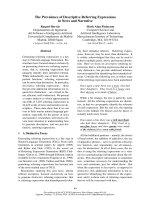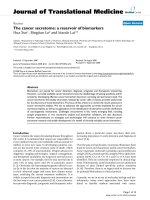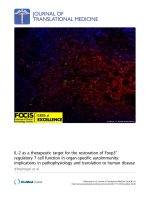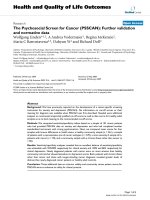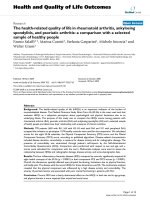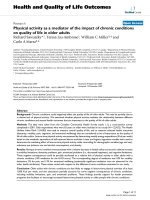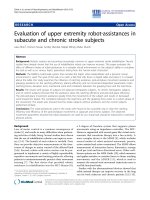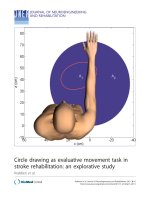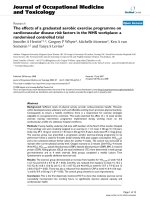báo cáo hóa học:" The PedsQL™ as a patient-reported outcome in children and adolescents with Attention-Deficit/Hyperactivity Disorder: a population-based study" pdf
Bạn đang xem bản rút gọn của tài liệu. Xem và tải ngay bản đầy đủ của tài liệu tại đây (315.43 KB, 10 trang )
BioMed Central
Page 1 of 10
(page number not for citation purposes)
Health and Quality of Life Outcomes
Open Access
Research
The PedsQL™ as a patient-reported outcome in children and
adolescents with Attention-Deficit/Hyperactivity Disorder: a
population-based study
James W Varni*
1
and Tasha M Burwinkle
2
Address:
1
Department of Pediatrics, College of Medicine, Department of Landscape Architecture and Urban Planning, College of Architecture,
Texas A&M University, 3137 TAMU, College Station, TX 77843-3137, USA and
2
The Children's Hospital at Scott & White, Department of
Pediatrics, Texas A&M University Health Science Center, 2401 South 31st Street, Temple, TX 76508, USA
Email: James W Varni* - ; Tasha M Burwinkle -
* Corresponding author
Abstract
Background: Attention-Deficit/Hyperactivity Disorder (ADHD) is the most common chronic
mental health condition in children and adolescents. The application of health-related quality of life
(HRQOL) as a pediatric population health measure may facilitate risk assessment and resource
allocation, the identification of health disparities, and the determination of health outcomes from
interventions and policy decisions for children and adolescents with ADHD at the local community,
state, and national health level.
Methods: An analysis from an existing statewide database to determine the feasibility, reliability,
and validity of the 23-item PedsQL™ 4.0 (Pediatric Quality of Life Inventory™) Generic Core
Scales as a patient-reported outcome (PRO) measure of pediatric population health for children
and adolescents with ADHD. The PedsQL™ 4.0 Generic Core Scales (Physical, Emotional, Social,
School Functioning) were completed by families through a statewide mail survey to evaluate the
HRQOL of new enrollees in the State of California State's Children's Health Insurance Program
(SCHIP). Seventy-two children ages 5–16 self-reported their HRQOL.
Results: The PedsQL™ 4.0 evidenced minimal missing responses, achieved excellent reliability for
the Total Scale Score (α = 0.92 child self-report, 0.92 parent proxy-report), and distinguished
between healthy children and children with ADHD. Children with ADHD self-reported severely
impaired psychosocial functioning, comparable to children with newly-diagnosed cancer and
children with cerebral palsy.
Conclusion: The results suggest that population health monitoring may identify children with
ADHD at risk for adverse HRQOL. The implications of measuring pediatric HRQOL for evaluating
the population health outcomes of children with ADHD internationally are discussed.
Background
While the importance of measuring pediatric health-
related quality of life (HRQOL) in clinical trials is increas-
ingly recognized for children with chronic health condi-
tions [1,2], the utility of pediatric HRQOL measurement
in population health outcome evaluation from the perspec-
Published: 21 April 2006
Health and Quality of Life Outcomes2006, 4:26 doi:10.1186/1477-7525-4-26
Received: 10 January 2006
Accepted: 21 April 2006
This article is available from: />© 2006Varni and Burwinkle; licensee BioMed Central Ltd.
This is an Open Access article distributed under the terms of the Creative Commons Attribution License ( />),
which permits unrestricted use, distribution, and reproduction in any medium, provided the original work is properly cited.
Health and Quality of Life Outcomes 2006, 4:26 />Page 2 of 10
(page number not for citation purposes)
tive of children in large pediatric populations has several
distinct benefits beyond the clinical setting. It can aid in
identifying subgroups of children who are at-risk for
health problems, in determining the burden of a particu-
lar disease or disability, and in informing efforts aimed at
prevention and intervention at the local community,
state, and national level [3-5]. In addition, utilization of
HRQOL measures at the population health level may assist
in the evaluation of the healthcare needs of a community,
and results can be used to influence public policy deci-
sions, including the development of strategic healthcare
plans, identifying health disparities, promoting policies
and legislation related to community health, and aiding
in the allocation of healthcare resources [6].
ADHD is the most common chronic mental health condi-
tion in children and adolescents [7]. Recently, a number
of studies have reported on the HRQOL of children with
ADHD utilizing parent proxy-reported instruments [8-
14]. These investigations have made an important contri-
bution by identifying the significant negative impact on
HRQOL of ADHD in children from the perspective of car-
egivers. However, given that patient self-report is consid-
ered the standard in patient-reported outcomes
measurement [15-18], a reliance on only parent proxy-
report is insufficient. There is a critical need to empirically
document the HRQOL of children with ADHD from their
perspective, or in other words, to "hear the voices of the
children" in matters pertaining to their health and well-
being for the youngest children possible [19]. Several
studies have investigated the HRQOL construct in ADHD
from the perspective of primarily young adolescent and
adolescent self-report [20,21], with the except of one
study which included a combined sample of children 6–
18 years of age referred for psychiatric services who were
diagnosed with a variety of disorders within a spectrum of
attention-deficit and disruptive behavior disorders [22].
Patient-reported outcomes (PROs) are self-report instru-
ments that directly measure the patient's perceptions of the
impact of disease and treatment as clinical trial endpoints,
and include multi-item HRQOL instruments, as well as
single-item measures (e.g., pain visual analogue scale),
daily diaries, treatment adherence, and healthcare satis-
faction [15,16,23]. Pediatric PROs must be sensitive to
cognitive development and should include both child
self-report and parent proxy-report to reflect their poten-
tially unique perspectives. However, imperfect agreement
between self and proxy report, termed cross-informant
variance [24], has been consistently documented in the
PRO measurement of children with chronic health condi-
tions and healthy children [25,26]. The demonstration of
cross-informant variance and the general acceptance that
HRQOL derives from an individual's perceptions [17],
indicates an essential need in pediatric HRQOL measure-
ment for reliable and valid child self-report instruments
for the broadest age range possible.
Although other pediatric HRQOL instruments exist,
including generic measures and disease-specific measures
[2,27], it has been an explicit goal of the Pediatric Quality
of Life Inventory™ (PedsQL™) Measurement Model [28]
to develop and test brief age-appropriate PRO measures
for the broadest age group empirically feasible, specifi-
cally including child self-report for the youngest children
possible [18,29]. This goal was originally articulated in
empirical efforts in the 1980's to measure pain perception
in pediatric patients through the development and testing
of the Varni/Thompson Pediatric Pain Questionnaire™ for
children as young as 5 years of age [30]. Thus, a major goal
of the PedsQL™ programmatic research efforts is to docu-
ment the potential for child self-report in patient popula-
tions in which proxy-report has been consider the
standard for young children [19].
Consequently, the primary objective of the present study
was to measure the perceived HRQOL of children with
ADHD from the perspective of the children at the population
health level utilizing the PedsQL™ 4.0 Generic Core Scales.
The data were derived from a statewide mail survey to
families with children ages 2–16 years throughout the
State of California encompassing all new enrollees in the
State's Children's Health Insurance Program (SCHIP) dur-
ing a two month period [4].
Based on the extant literature on HRQOL in pediatric
chronic health conditions in general [27], and ADHD in
particular [22], we hypothesized that children with
ADHD would self-report significantly lower psychosocial
health than healthy children, while self-reporting only
slightly lower physical health. We further examined the
concordance between child self-report and parent proxy-
report, expecting moderate agreement based on the extant
literature with the PedsQL™ in pediatric chronic health
conditions [31-33] and psychiatric disorders [34]. In
order to further determine the clinical magnitude of the
hypothesized negative impact of ADHD on pediatric
patient self-reported HRQOL, we conducted comparative
analyses between children with ADHD and children with
newly-diagnosed cancer and children with cerebral palsy,
both groups who have previously demonstrated signifi-
cantly impaired self-reported HRQOL using the PedsQL™
[19,31].
Method
SCHIP sampling frame and procedure
The PedsQL™ 4.0 survey was mailed separately for each of
the months of February and March 2001 to 20,031 fami-
lies with children ages 2–16 years throughout the State of
California, which encompassed all new enrollees in the
Health and Quality of Life Outcomes 2006, 4:26 />Page 3 of 10
(page number not for citation purposes)
State's Children's Health Insurance Program (SCHIP) for
those months and for those ages and for parents and/or
children who were English-, Spanish-, Vietnamese-,
Korean-, or Cantonese-speaking [4]. The overall return
rate was 51%. This response rate was expected for the
mode and method of survey administration utilized,
which involved a one-time only statewide mailing given
limited funding from the sponsor which did not permit
more follow-up contacts [35]. Although the PedsQL™ 4.0
can be administered to children ages 2–18, children older
than 16 years of age were not included in this field test
because a two-year follow-up was anticipated (the oldest
children in the sample would be 18 years old at the 2-year
follow-up). The mail survey mode of administration was
paper-and-pencil self-administration for parents and chil-
dren ages 8 to 16, and parent-assisted administration for
children ages 5 to 7. Since we were primarily interested in
child self-report for ages 5–16, we did not include analy-
ses of data for parent proxy-report for children ages 2–4.
DataStat, a nationally-based survey administration firm
located in Michigan, was contracted to administer the Cal-
ifornia SCHIP statewide mail survey. DataStat mailed the
PedsQL™ 4.0 survey, together with a cover letter to all eli-
gible SCHIP families during the two month period
selected by the State of California. Parents and children
were instructed in the cover letter to complete the Ped-
sQL™ 4.0 separately, except for children ages 5–7, who
were assisted by their parents after the parent completed
the proxy-report. Parents were also instructed to complete
the additional survey items after completing the PedsQL™
4.0. In order to assure the anonymity and confidentiality
of the respondent's answers and the neutrality of the
organization gathering the data, all surveys were mailed
back to DataStat. Since the intent of the SCHIP project was
program evaluation and not research, parents and chil-
dren did not complete informed consent forms, as
described in the original report [4]. Consequently, dei-
dentified data were analyzed for this report by the investi-
gators. This protocol of analyzing existing deidentified
data was approved by the Institutional Review Board at
Children's Hospital and Health Center, San Diego.
Healthy children SCHIP sample
The healthy children subgroup sample was derived from
the PedsQL™ 4.0 SCHIP total sample [4]. The healthy
sample was randomly matched by age group to the ADHD
sample prior to analysis (i.e., an equal percentage of
healthy children in each age group was randomly selected
to match the ADHD sample by age group using the SPSS
random sample case selection command). Child self-
report and parent proxy-report were available for all cases.
The average age of the 1693 boys (51.9 %) and 1567 girls
(48.1 %) was 10.75 years (SD = 3.10). The sample was
heterogeneous with respect to race/ethnicity, with 478
(14.7 %) White non-Hispanic, 1971 (60.5 %) Hispanic,
69 (2.1 %) Black non-Hispanic, 389 (11.9 %) Asian/
Pacific Islander, 13 (0.4 %) American Indian or Alaskan
Native, and 340 (10.4 %) missing. The statewide SCHIP
sample was representative of low-income families (≤
250% of the federal poverty level) [4].
ADHD SCHIP sample
The ADHD subgroup sample was derived from the same
PedsQL™ 4.0 SCHIP total sample as the healthy children
subgroup sample [4]. For 72 children ages 5 to 16 years,
child self-report was available. The average age of the 60
boys (83.3%) and 12 girls (16.7%) was 10.95 years (SD =
3.13) with a range of 5 to 16 years. The sample was heter-
ogeneous with respect to race/ethnicity, with 31 (43.1%)
White, 16 (22.2%) Hispanic/Latino, 7 (9.7%) Black/Afri-
can American, 7 (9.7%) Asian/Pacific Islander, 2(2.8%)
Native American or Native Alaskan, and 9 (12.5%) miss-
ing. The statewide SCHIP sample was representative of
low-income families, that is, incomes at or below 250% of
the federal poverty level) [4].
Pediatric cancer sample
The cancer sample was derived from the PedsQL™ Cancer
Module field test [31], and randomly matched by age
group to the ADHD sample. The sample included newly-
diagnosed children with acute lymphocytic leukemia (n =
44, 61.1%), brain tumor (n = 6, 8.3%) non-Hodgkin's
lymphoma (n = 4, 5.6%), Hodgkin's lymphoma (n = 2,
2.8%), Wilm's tumor (n = 1, 1.4%), and other cancers (n
= 15, 20.8%). For all forms combined, the average age of
the 38 boys (52.8%) and 33 girls (45.8%; Missing = 1,
1.4%) was 10.35 years (SD = 3.29) with a range of 5 to 16
years. For child self-report, the average age of the 35 boys
(53.0%) and 30 girls (45.5%; Missing = 1, 1.5%). was
10.65 years (SD = 3.20). The sample was heterogeneous
with respect to race/ethnicity, with 24 (33.3%) White
non-Hispanic, 35 (48.6%) Hispanic, 3 (4.2%) Black non-
Hispanic, 1 (1.4%) Asian/Pacific Islander, 1 (1.4%) Amer-
ican Indian or Alaskan Native, and 8 (11.1%) missing.
Mean socioeconomic status (SES) was 32.45 (SD =
15.61), indicating on average a lower middle class sample
based on the Hollingshead index[36].
Pediatric cerebral palsy sample
The cerebral palsy sample was derived from the PedsQL™
Cerebral Palsy Module field test [37], and randomly
matched by age group to the ADHD sample. The sample
included children with hemiplegia (N = 22 (37.9%),
diplegia (N = 22, 37.9%), and quadriplegia (N = 8, 13.8%;
Missing = 6, 10.3%). Child self-report and parent proxy-
report were available for all cases. For all forms combined,
the average age of the 30 boys (51.7%) and 27 girls
(46.6%; Missing = 1, 1.7%) was 9.79 years (SD = 3.14)
with a range of 5 to 16 years. The sample was heterogene-
Health and Quality of Life Outcomes 2006, 4:26 />Page 4 of 10
(page number not for citation purposes)
ous with respect to race/ethnicity, with 23 (39.7%) White
non-Hispanic, 17 (29.3%) Hispanic, 5 (8.6%) Black non-
Hispanic, 5 (8.6%) Asian/Pacific Islander, and 8 (13.8%)
missing. Mean socioeconomic status (SES) was 40.33 (SD
= 14.45), indicating on average a lower middle to middle
class sample based on the Hollingshead index [36].
Measures
The PedsQL™ 4.0 (Pediatric quality of Life inventory™
Version 4.0)
The 23-item PedsQL™ 4.0 Generic Core Scales encompass:
1) Physical Functioning (8 items), 2) Emotional Func-
tioning (5 items), 3) Social Functioning (5 items), and 4)
School Functioning (5 items), and were developed
through focus groups, cognitive interviews, pre-testing,
and field testing measurement development protocols
[29]. The instrument takes approximately 5 minutes to
complete [29]. The child self-report items are contained in
the Appendix.
The PedsQL™ 4.0 Generic Core Scales are comprised of
parallel child self-report and parent proxy-report formats.
Child self-report includes ages 5–7, 8–12, and 13–18
years. Parent proxy-report includes ages 2–4 (toddler), 5–
7 (young child), 8–12 (child), and 13–18 (adolescent),
and assesses parent's perceptions of their child's HRQOL.
The items for each of the forms are essentially identical,
differing in developmentally appropriate language, or first
or third person tense. The instructions ask how much of a
problem each item has been during the past one month.
A 5-point response scale is utilized across child self-report
for ages 8–18 and parent proxy-report (0 = never a prob-
lem; 1 = almost never a problem; 2 = sometimes a prob-
lem; 3 = often a problem; 4 = almost always a problem).
To further increase the ease of use for the young child self-
report (ages 5–7), the response scale is reworded and sim-
plified to a 3-point scale (0 = not at all a problem; 2 =
sometimes a problem; 4 = a lot of a problem), with each
response choice anchored to a happy to sad faces scale.
Items are reverse-scored and linearly transformed to a 0–
100 scale (0 = 100, 1 = 75, 2 = 50, 3 = 25, 4 = 0), so that
higher scores indicate better HRQOL. Scale Scores are
computed as the sum of the items divided by the number
of items answered (this accounts for missing data). If
more than 50% of the items in the scale are missing, the
Scale Score is not computed. This accounts for the differ-
ences in sample sizes for scales reported in the Tables.
Although there are other strategies for imputing missing
values, this computation is consistent with the previous
PedsQL™ peer-reviewed publications, as well as other
well-established HRQOL measures [29,38,39]. For this
study, over 95% of child and parent respondents were
included in the Scale Score analyses after imputing miss-
ing values. The Physical Health Summary Score (8 items)
is the same as the Physical Functioning Subscale. To create
the Psychosocial Health Summary Score (15 items), the
mean is computed as the sum of the items divided by the
number of items answered in the Emotional, Social, and
School Functioning Subscales.
Additional survey items
The parents completed several additional survey items
adapted from the PedsQL™ Family Information Form
[29]. One survey question asked the parent to report on
the presence of a chronic health condition ("In the past 6
months, has your child had a chronic health condition?")
defined as a physical or mental health condition that has
lasted or is expected to last at least 6 months and interferes
with the child's activities. If the parents check "Yes" to this
question, they were asked "Which of the following
chronic illnesses does your child suffer from?" The list
provided consisted of asthma, diabetes, attention deficit/
hyperactivity disorder (ADHD), depression, and other
(write in). Parents who selected ADHD comprised the
sample reported herein.
Statistical analysis
The feasibility of the PedsQL™ 4.0 as a population health
measure in ADHD was determined from the percentage of
missing values for each item [29,38,39]. Scale internal
consistency reliability was determined by calculating
Cronbach's coefficient alpha. Scales with reliabilities of
0.70 or greater are recommended for comparing patient
groups, while a reliability criterion of 0.90 is recom-
mended for analyzing individual patient scale scores [40].
Construct validity was determined utilizing the known-
groups method. The known-groups method compares
scale scores across groups known to differ in the health
construct being investigated. In this study, analysis of var-
iance with Tukey post-hoc tests was used to compare
groups differing in known health status (ADHD versus
cancer, CP, and healthy). Although the Tukey post-hoc
test is among the more conservative post-hoc approaches
(therefore reducing the likelihood of Type I error), a Bon-
ferroni correction was applied to account for multiple
comparisons (in this study, 4 groups × 6 summary scores
= 24/.05 = 0.002 adjusted alpha level for significance). In
order to determine the magnitude of the differences
between children with ADHD and healthy children, effect
sizes were calculated [41]. Effect size as utilized in these
analyses was calculated by taking the difference between
the healthy sample mean and the ADHD sample mean,
divided by the healthy sample standard deviation. Effect
sizes for differences in means are designated as small
(.20), medium (.50), and large (.80) in magnitude [41].
We also explored similarities and differences in PedsQL™
scores between the ADHD sample with the cancer and cer-
ebral palsy samples.
Health and Quality of Life Outcomes 2006, 4:26 />Page 5 of 10
(page number not for citation purposes)
The concordance between patient self-report and parent
proxy-report was determined through correlation coeffi-
cients. Pearson Product Moment Correlation coefficient
effect sizes are designated as small (.10–.29), medium
(.30–.49), and large (≥50) [41]. Intraclass correlations
(ICC) were also computed, designated as ≤0.40 poor to
fair agreement, 0.41–0.60 moderate agreement, 0.61–
0.80 good agreement, and 0.81–1.00 excellent agreement
[42,43].
Statistical analyses were conducted with SPSS. Response
equivalence has been previously demonstrated across lan-
guage for the PedsQL™ by examining the percent missing
data, floor and ceiling effects, and scale internal consist-
ency across language, as well as across mode of adminis-
tration [29]. Responses were therefore pooled (i.e.,
analyses included responses on all language forms of the
PedsQL™).
Results
Feasibility
To assess instrument feasibility, the percentage of missing
values was calculated. For child self-report and parent
proxy-report, the percentage of missing item responses for
the ADHD sample was 0.0% and 4.9%, respectively. The
majority of the missing item responses for parent proxy-
report were a function of 3 parents who did not complete
enough items to derive scale or summary scores.
Descriptive statistics
Table 1 presents the means and standard deviations of the
PedsQL™ 4.0 scores for child self-report and parent proxy-
report. The mean ADHD scale scores for the survey sample
are generally consistent with the PedsQL™ 4.0 scores for a
clinic sample of newly-referred pediatric patients with a
physician-derived mixed diagnostic group which included
ADHD in The Netherlands [22].
Internal consistency reliability
Internal consistency reliability alpha coefficients by age
group are presented in Table 2. The majority of the child
self-report scales and parent proxy-report scales exceeded
the minimum reliability standard of 0.70 required for
group comparisons, while the Total Scale Score across the
ages approached or exceeded the reliability criterion of
0.90 recommended for analyzing individual patient scale
scores.
Construct validity
Table 1 contains the PedsQL™ 4.0 scores for children with
ADHD and healthy children within the SCHIP sample.
Consistent with previous research [22], children with
ADHD scored significantly lower on the Psychosocial
Health scales than healthy children, with smaller differ-
ences observed on the Physical Functioning Scale. Most
effect sizes were in the large range.
Comparison to pediatric cancer and cerebral palsy
Table 1 demonstrates that children with ADHD in this
sample reported psychosocial health comparable to child
and parent reports of children with newly-diagnosed chil-
dren receiving cancer treatment and children with cerebral
palsy.
Table 1: PedsQL™ 4.0 Generic Core Scales Scores for Child Self-Report and Parent Proxy-Report across Samples
ADHD
a
Cancer
b
Cerebral Palsy
c
Healthy
d
Differences Effect Size
Scale Mean SD Mean SD Mean SD Mean SD
Self-Report (N = 72) (N = 66) (N = 57) (N = 3256)
Total Score 70.17 18.28 68.95 15.15 66.27 15.90 84.29 12.56 a<d*** 1.12
Physical Functioning 82.63 17.47 65.81 20.33 64.81 21.36 88.02 13.26 b, c<a***; a<d** .41
Psychosocial Health 63.52 21.05 70.81 15.31 67.00 16.08 82.31 13.95 a<b*; a<d*** 1.35
Emotional Functioning 65.27 25.74 68.94 20.52 66.16 23.34 79.45 18.00 a<d*** 0.79
Social Functioning 65.55 28.12 78.64 18.38 70.18 18.94 85.95 16.49 a<b***; a<d*** 1.24
School Functioning 59.76 21.23 64.26 19.64 64.62 21.11 81.50 16.10 a<d*** 1.35
Proxy-Report (N = 69) (N = 71) (N = 57) (N = 3251)
Total Score 69.50 16.17 60.67 19.09 56.27 17.27 79.87 16.24 b<a**; c<a***; a<d*** 0.64
Physical Functioning 84.61 15.89 56.75 26.34 53.31 24.28 81.76 20.82 b, c<a*** 0.14
Psychosocial Health 61.43 18.79 63.12 17.68 57.85 16.71 78.85 16.00 a<d*** 1.09
Emotional Functioning 64.36 21.16 58.10 21.96 61.40 18.70 79.51 17.32 a<d*** 0.87
Social Functioning 65.11 26.92 71.23 19.62 54.74 21.64 80.98 20.85 c<a*; a<d*** 0.76
School Functioning 53.83 19.10 61.42 21.59 57.39 19.86 76.01 19.66 a<d*** 1.13
Note: ADHD = Attention-Deficit/Hyperactivity Disorder. SCHIP = State's Children's Health Insurance Program. Three parents of children with
ADHD did not complete enough items to calculate subscale or summary scores.
*p < .05, **p < .01, ***p < .001 based on Tukey post-hoc analysis. Effect sizes are designated as small (.20), medium (.50), and large (.80). Effect sizes
represent the magnitude in the differences between the ADHD and healthy samples only.
With a Bonferroni correction for the number of comparisons, differences at p < .05 and .01 should be considered heuristic/exploratory.
Health and Quality of Life Outcomes 2006, 4:26 />Page 6 of 10
(page number not for citation purposes)
Parent/child concordance
Table 3 shows the intercorrelations between PedsQL™ 4.0
child self-report and parent proxy-report. The overall scale
intercorrelations are generally consistent with other Ped-
sQL™ 4.0 studies [31-33], with most effect sizes in the
medium to large range.
Discussion
These analyses from an existing database support the fea-
sibility, reliability and validity of the PedsQL™ 4.0 as a
child self-report and parent proxy-report HRQOL meas-
urement instrument for pediatric population health monitor-
ing for children and adolescents with ADHD. Items on the
PedsQL™ 4.0 had minimal missing responses, suggesting
that children and parents are willing and able to provide
good quality data regarding the child's HRQOL at the
population health level.
The PedsQL™ 4.0 self-report and proxy-report internal
consistency reliabilities generally exceeded the recom-
mended minimum alpha coefficient standard of 0.70 for
group comparisons. The PedsQL™ 4.0 Generic Core Scales
Total Score and the Psychosocial Health Summary Score
for child self-report and parent proxy-report approached
or exceeded an alpha of 0.90, recommended for individ-
ual patient analysis [40], making the Total Scale Score
suitable as a summary score for the primary analysis of
HRQOL outcome in population health analyses for chil-
dren with ADHD, with the PedsQL™ Psychosocial Health
Summary Score suitable alternatively as either the primary
or secondary outcome score depending on the intent of a
particular clinical trial.
As hypothesized, children with ADHD self-reported signifi-
cantly lower PedsQL™ scores on dimensions of psychosocial
health and slightly lower but not statistically significant dif-
ferences in physical functioning in comparison to healthy
children. These findings are consistent with PedsQL™
ADHD findings from The Netherlands [
22
] and Thailand
[
44
]. These multinational consistencies support the poten-
tial international generalizability of these findings. It
should be noted that these findings are not consistent with
a study which found no differences between healthy chil-
dren and children with ADHD using the CHQ self-report
Table 2: PedsQL™ 4.0 Generic Core Scales Internal Consistency Reliability for Child Self-Report and Parent Proxy-Report for ADHD
Sample by Age and Summary Score/Subscale
Scale Age Group
Young Child 5–7 Child 8–12 Adolescent 13–18 Total Sample
Child Self-Report (n = 13) (n = 37) (n = 22) (n = 72)
Total Score 0.86 0.93 0.94 0.92
Physical Functioning 0.63 0.84 0.89 0.83
Psychosocial Health 0.86 0.91 0.92 0.90
Emotional Functioning 0.83 0.89 0.85 0.87
Social Functioning 0.85 0.89 0.90 0.88
School Functioning 0.52 0.70 0.82 0.74
Parent Proxy-Report (n = 13) (n = 35) (n = 21) (n = 69)
Total Score 0.80 0.92 0.94 0.92
Physical Functioning 0.61 0.87 0.78 0.81
Psychosocial Health 0.83 0.89 0.95 0.90
Emotional Functioning 0.79 0.85 0.85 0.84
Social Functioning 0.78 0.90 0.91 0.88
School Functioning 0.54 0.70 0.88 0.76
Table 3: Intercorrelations between PedsQL™ 4.0 Generic Core
Scales Child Self-Report and Parent Proxy-Report for ADHD
Sample
PedsQL™ Scale Score Intercorrelations
Total Scale Score 0.71***
0.70***
Physical Functioning 0.67***
0.67***
Psychosocial Health 0.69***
0.69***
Emotional Functioning 0.67***
0.66***
Social Functioning 0.75***
0.75***
School Functioning 0.59***
0.59***
***p < .001.
Effect sizes are designated as small (.10), medium (.30), and large (.50)
for Pearson Product Moment correlations.
Intraclass correlations (ICC) are designated as ≤0.40 poor to fair
agreement, 0.41–0.60 moderate agreement, 0.61–0.80 good
agreement, and 0.81–1.00 excellent agreement. Single Measure
Intraclass Correlation Coefficients (ICC) are listed in italics below
Pearson Product Moment correlation values. ICC values were derived
using a single measure model.
Health and Quality of Life Outcomes 2006, 4:26 />Page 7 of 10
(page number not for citation purposes)
version [
21
], which may reflect age and instrument differ-
ences or true inconsistencies with the current findings using
the PedsQL™. However, given the number of proxy-reported
differences between healthy children and children with
ADHD reported in the literature, we believe the consistency
of the present findings with the PedsQL™ of differences
between healthy children and children with ADHD with
both
child self-report and parent proxy-report support a true
difference. Once again, this illustrates the benefits of the
PedsQL™ Measurement Model in which both child self-
report and parent proxy-report are advocated [
28
].
The comparisons between children with ADHD with chil-
dren with newly-diagnosed cancer and those children
with cerebral palsy are useful in understanding the relative
impact of ADHD on HRQOL. The extant literature on the
adaptation of children with chronic physical health con-
ditions demonstrates that children with chronic physical
health conditions are reported to not only experience
lower physical functioning, but also manifest lower emo-
tional, social, and school functioning in comparison to
healthy children [45]. Thus, the findings that children
with ADHD, a chronic mental health condition, report
psychosocial health comparable to children receiving
chemotherapy and radiation for the treatment of newly-
diagnosed cancer and children with cerebral palsy who are
able to self-report their psychosocial functioning, provide
further insight into the comparative impact of these pedi-
atric chronic health conditions on HRQOL. The addi-
tional strength of these findings are that they make
conceptual sense as well, given that the children with
ADHD in the present study, while reporting comparable
psychosocial health to children with cancer and cerebral
palsy, reported significantly better physical functioning in
comparison to these children with severe chronic physical
health conditions.
These findings with the PedsQL™ 4.0 have potential
implications for the healthcare needs of children with
ADHD. Given that these children were newly enrolled in
a state health insurance program for poor families, it
seems reasonable to assume that they did not have prior
regular access to healthcare at the time of their enroll-
ment. In fact, the similarity of these findings to children
newly-referred to a hospital-based psychiatry clinic in The
Netherlands suggests that children with ADHD who are
not yet receiving regular treatment may be at significant
risk for considerable psychosocial health impairment, and
to a lesser extent, physical health impairment. The imme-
diate and long-term consequences of untreated or under-
treated ADHD can be quite severe for children, their fam-
ilies, and society, given previous research which has dem-
onstrated that ADHD severity is associated with great
comorbid psychopathology [7].
The challenge for healthcare systems, States and Nations
is to identify and enroll children with ADHD in evidence-
based quality comprehensive healthcare services in order
to mitigate these potential long-term negative conse-
quences on child HRQOL. Given that stimulant medica-
tions have emerged as the first line of effective therapy for
the treatment of ADHD [46], trials which evaluate the
impact of stimulant medications on HRQOL outcomes
are indicated [47].
Finally, while self-report is considered the standard for
measuring perceived HRQOL, it is typically parents' per-
ceptions of their children's HRQOL that influences
healthcare utilization [48-50]. Thus, the imperfect agree-
ment observed between child self-report and parent
proxy-report supports the need to measure the perspec-
tives of both the child and parent in evaluating pediatric
HRQOL since these perspectives may be independently
related to healthcare utilization and risk factors. The avail-
ability of a validated parent proxy-report measure in pedi-
atric population health provides the opportunity to
estimate child HRQOL when the child is either unable or
unwilling to complete the HRQOL measure, or as proxy
information when young child self-report scale reliabili-
Table 4: Appendix A PedsQL™ 4.0 Generic Core Scales Child
Self-Report Item Content
Physical Functioning Scale
1. It is hard for me to walk more than one block
2. It is hard for me to run
3. It is hard for me to do sports activity or exercise
4. It is hard for me to lift something heavy
5. It is hard for me to take a bath or shower by myself
6. It is hard for me to do chores around the house
7. I hurt or ache
8. I have low energy
Emotional Functioning Scale
1. I feel afraid or scared
2. I feel sad or blue
3. I feel angry
4. I have trouble sleeping
5. I worry about what will happen to me
Social Functioning Scale
1. I have trouble getting along with other kids
2. Other kids do not want to be my friend
3. Other kids tease me
4. I cannot do things that other kids my age can do
5. It is hard to keep up when I play with other kids
School Functioning Scale
1. It is hard to pay attention in class
2. I forget things
3. I have trouble keeping up with my schoolwork
4. I miss school because of not feeling well
5. I miss school to go to the doctor or hospital
Reproduced with permission from J.W. Varni, Ph.D. Copyright
©
1998.
PedsQL™ is available at
Health and Quality of Life Outcomes 2006, 4:26 />Page 8 of 10
(page number not for citation purposes)
ties do not achieve the 0.70 standard. Although the inter-
correlations between child and parent report across the
physical, emotional, social, and school domains might be
expected to follow the conceptualization that more
observable domains (i.e., physical functioning) would
yield higher intercorrelations, this has not necessary been
the case in either PedsQL™ publications across various
pediatric chronic health conditions, nor the published lit-
erature with other HRQOL instruments. In a comprehen-
sive review, Eiser [27] found mixed results in terms of
higher intercorrelations between self and proxy report of
physical functioning across pediatric HRQOL instru-
ments, with most studies demonstrating this effect, while
some others did not. For previous PedsQL™ 4.0 publica-
tions, we have generally found higher self and proxy
report intercorrelations for physical functioning in com-
parison to the other domains, although these differences
have not been large, except for children with arthritis and
other rheumatologic conditions and children with cere-
bral palsy in which physical functioning is a salient con-
cern [33,37]. For children with diabetes, in which physical
functioning is not as salient a concern, the intercorrela-
tion between self and proxy report on the physical func-
tioning scale was not the highest intercorrelation [51].
Thus, the findings across PedsQL™ studies appear consist-
ent with the extant pediatric HRQOL literature across dif-
ferent instruments in regards to the effect sizes of the
intercorrelations between the physical functioning and
other relevant HRQOL domains, while the present find-
ings with a chronic mental health condition suggest rather
similar patient/parent concordance across the physical
and psychosocial dimensions.
The present findings have several potential limitations.
Given that this was a population-based mail survey, there
are no guarantees that the children and parents independ-
ently completed the PedsQL™. However, if that bias
existed, it would be anticipated that the bias would be
equally distributed across the healthy children and chil-
dren with ADHD. Parents reported on their children's
chronic health conditions for the SCHIP evaluation in
general, including the presence of an ADHD diagnosis for
the purposes of the present analysis. Objective measures
of chronic health condition would strengthen the valida-
tion process. However, in previous PedsQL™ 4.0 clinical
research in pediatric patients with cancer, cardiac and
rheumatic chronic health conditions, and more specifi-
cally, children with psychiatric disorders, objective medi-
cal diagnosis of these chronic diseases demonstrated
similar differences between healthy children and children
with ADHD, psychiatric disorders, and with chronic
health conditions as shown in the present findings. Nev-
ertheless, we are now conducting PedsQL™ research with
physician-diagnosed ADHD to further extend these find-
ings to the clinic setting. Finally, while the ADHD and
healthy samples were derived from the same population
sample, the cancer and cerebral palsy samples are from a
clinic-based sample which may represent differences in
terms of SES. However, the differences between the gener-
ally lower middle class clinic samples and the population
sample are not large, but future research will need to
match or control for these potential differences, including
gender differences.
Conclusion
These PedsQL™ 4.0 findings demonstrate the feasibility
and measurement properties required for community and
general population health survey research and evaluation
for children with ADHD. Measuring perceived health
from the perspective of children and their parents pro-
vides a level of accountability consistent with the Institute
of Medicine report on the quality of care [52]. Addition-
ally, population-wide monitoring has been recom-
mended for addressing socioeconomic, racial, and ethnic
disparities in healthcare quality [53]. As the consumers of
pediatric healthcare, children with ADHD and parents are
uniquely positioned to give their perspectives on health-
care quality through their perceptions of child health-
related quality of life outcomes.
Abbreviations
HRQOL Health-Related Quality of Life
PedsQL™ Pediatric Quality of Life Inventory™
PRO Patient-Reported Outcomes
Competing interests
The author(s) declare that they have no competing inter-
ests.
Authors' contributions
JWV conceptualized the rationale and design of the study.
JWV designed the instrument and drafted the manuscript.
TMB participated in study conceptualization and design,
and performed the statistical analysis. All authors read
and approved the final manuscript.
Acknowledgements
This research was supported by a grant from the David and Lucile Packard
Foundation. Dr. Varni holds the copyright and the trademark for the Ped-
sQL™ and receives financial compensation from the Mapi Research Trust,
which is a nonprofit research institute that charges distribution fees to for-
profit companies that use the Pediatric Quality of Life Inventory™. The
PedsQL™ is available at
References
1. Eiser C: Use of quality of life measures in clinical trials. Ambu-
latory Pediatrics 2004, 4:395-399.
2. Matza LS, Swensen AR, Flood EM, Secnik K, Leidy NK: Assessment
of health-related quality of life in children: A review of con-
ceptual, methodological, and regulatory issues. Value in Health
2004, 7:79-92.
Health and Quality of Life Outcomes 2006, 4:26 />Page 9 of 10
(page number not for citation purposes)
3. Kaplan RM: Quality of life in children: A health care policy per-
spective. In Quality of life in child and adolescent illness: Concepts, meth-
ods, and findings Edited by: Koot HM, Wallander JL. East Sussex, Great
Britain: Brunner-Routledge; 2001:89-120.
4. Varni JW, Burwinkle TM, Seid M, Skarr D: The PedsQL™ 4.0 as a
pediatric population health measure: Feasibility, reliability,
and validity. Ambulatory Pediatrics 2003, 3:329-341.
5. Varni JW, Burwinkle TM, Seid M: The PedsQL™ 4.0 as a school
population health measure: Feasibility, reliability, and valid-
ity. Quality of Life Research 2006, 15:203-215.
6. Centers for Disease Control and Prevention: Measuring healthy
days: Population assessment of health-related quality of life.
Atlanta, Georgia: CDC; 2000.
7. Connor DF, Edwards G, Fletcher KE, Baird J, Barkley RA, Steingard
RJ: Correlates of comorbid psychopathology in children with
ADHD. Journal of the American Academy of Child and Adolescent Psy-
chiatry 2003, 42:193-200.
8. Matza LS, Secnik K, Mannix S, Sallee FR: Parent-proxy EQ-5D rat-
ings of children with attention-deficit hyperactivity disorder
in the US and the UK. Pharmacoeconomics 2005, 23:777-790.
9. Matza LS, Secnik K, Rentz AM, Mannix S, Sallee FR, Gilbert D, Revicki
DA: Assessment of health state utilities for attention-deficit/
hyperactivity disorder in children using parent proxy report.
Quality of Life Research 2005, 14:735-747.
10. Rentz AM, Matza LS, Secnik K, Swensen A, Revicki DA: Psychomet-
ric validation of the child health questionnaire (CHQ) in a
sample of children and adolescents with attention-deficit/
hyperactivity disorder. Quality of Life Research 2005, 14:719-734.
11. Klassen AF, Miller A, Fine S: Health-related quality of life in chil-
dren and adolescents who have a diagnosis of attention-defi-
cit/hyperactivity disorder. Pediatrics 2004, 114:e541-e547.
12. Escobar R, Soutullo CA, Hervas A, Gastaminza X, Polavieja P, Gilab-
erte I: Worse quality of life for children with newly diagnosed
attention-deficit/hyperactivity disorder compared with asth-
matic and healthy children. Pediatrics 2005, 116:e364-e369.
13. Landgraf JM, Rich M, Rappaport L: Measuring quality of life in chil-
dren with attention-deficit/hyperactivity disorder and their
families: Development and evaluation of a new tool. Archives
of Pediatric and Adolescent Medicine 2002, 156:384-391.
14. Sawyer MG, Whaites L, M RJ, Hazell PL, Graetz BW, Baghurst P:
Health-related quality of life of children and adolescents with
mental disorders. Journal of the American Academy of Child and Ado-
lescent Psychiatry 2002, 41:530-537.
15. Acquadro C, Berzon R, Dubois D, Leidy NK, Marquis P, Revicki D,
Rothman M: Incorporating the patient's perspective into drug
development and communication: An ad hoc task force
report of the patient-reported outcomes (PRO) harmoniza-
tion group meeting at the Food and Drug Administration,
February 16, 2001. Value in Health 2003, 6:522-531.
16. Willke RJ, Burke LB, Erickson P: Measuring treatment impact: A
review of patient-reported outcomes and other efficacy end-
points in approved product labels. Controlled Clinical Trials 2004,
25:535-552.
17. Fayers PM, Machin D: Quality of life: Assessment, analysis, and
interpretation. New York: Wiley; 2000.
18. Varni JW, Burwinkle TM, Seid M: The PedsQL™ as a pediatric
patient-reported outcome: Reliability and validity of the
PedsQL™ Measurement Model in 25,000 children. Expert
Review of Pharmacoeconomics and Outcomes Research 2005, 5:705-719.
19. Varni JW, Burwinkle TM, Sherman SA, Hanna K, Berrin SJ, Malcarne
VL, Chambers HG: Health-related quality of life of children and
adolescents with cerebral palsy: Hearing the voices of the
children. Developmental Medicine and Child Neurology 2005,
47:592-597.
20. Topolski TD, Edwards TC, Patrick DL, Varley P, Way ME, Buesching
DP: Quality of life of adolescent males with attention-deficit
hyperactivity disorder. Journal of Attention Disorders 2004,
7:163-173.
21. Landgraf JM, Abetz LN: Functional status and well-being of chil-
dren representing three cultural groups: Initial self-reports
using the CHQ-CF87. Psychology and Health 1997, 12:839-854.
22. Bastiaansen D, Koot HM, Ferdinand RF, Verhulst FC: Quality of life
in children with psychiatric disorders: Self, parent, and clini-
cian report. Journal of the American Academy of Child and Adolescent
Psychiatry 2004, 43:221-230.
23. Szende A, Leidy NK, Revicki D: Health-related quality of life and
other patient-reported outcomes in the European central-
ized drug regulatory process: A review of guidance docu-
ments and performed authorizations of medicinal products
1995 to 2003. Value in Health 2005, 8:534-548.
24. Varni JW, Katz ER, Colegrove R, Dolgin M: Adjustment of children
with newly diagnosed cancer: Cross-informant variance. Jour-
nal of Psychosocial Oncology 1995, 13:23-38.
25. Eiser C, Morse R: Can parents rate their child's health-related
quality of life?: Results from a systematic review. Quality of Life
Research 2001, 10:347-357.
26. Koot HM, Wallander JL, (eds.): Quality of life in child and adoles-
cent illness: Concepts, methods and findings. East Sussex, UK:
Brunner-Routledge; 2001.
27. Eiser C, Morse R: Quality of life measures in chronic diseases
of childhood. Health Technology Assessment 2001, 5:1-158.
28. Varni JW, Seid M, Rode CA: The PedsQL™: Measurement
model for the Pediatric Quality of Life Inventory. Medical Care
1999, 37:126-139.
29. Varni JW, Seid M, Kurtin PS: The PedsQL™ 4.0: Reliability and
validity of the Pediatric Quality of Life Inventory™ Version
4.0 Generic Core Scales in healthy and patient populations.
Medical Care 2001, 39:800-812.
30. Varni JW, Thompson KL, Hanson V: The Varni/Thompson Pedi-
atric Pain Questionnaire: I. Chronic musculoskeletal pain in
juvenile rheumatoid arthritis. Pain 1987, 28:27-38.
31. Varni JW, Burwinkle TM, Katz ER, Meeske K, Dickinson P: The Ped-
sQL™ in pediatric cancer: Reliability and validity of the Pedi-
atric Quality of Life Inventory™ Generic Core Scales,
Multidimensional Fatigue Scale, and Cancer Module. Cancer
2002, 94:2090-2106.
32. Varni JW, Burwinkle TM, Rapoff MA, Kamps JL, Olson N: The Ped-
sQL™ in pediatric asthma: Reliability and validity of the
Pediatric Quality of Life Inventory ™ Generic Core Scales
and Asthma Module. Journal of Behavioral Medicine 2004,
27:297-318.
33. Varni JW, Seid M, Knight TS, Burwinkle TM, Brown J, Szer IS: The
PedsQL™ in pediatric rheumatology: Reliability, validity,
and responsiveness of the Pediatric Quality of Life Inven-
tory™ Generic Core Scales and Rheumatology Module.
Arthritis and Rheumatism 2002, 46:714-725.
34. Bastiaansen D, Koot HM, Bongers IL, Varni JW, Verhulst FC: Meas-
uring quality of life in children referred for psychiatric prob-
lems: Psychometric properties of the PedsQL 4.0 Generic
Core Scales. Quality of Life Research 2004, 13:489-495.
35. Dillman DA: Mail and internet surveys: The tailored design
method. 2nd edition. New York: Wiley; 2000.
36. Hollingshead AB: Four factor index of social status. New Haven,
CT: Yale University; 1975.
37. Varni JW, Burwinkle TM, Berrin SJ, Sherman SA, Artavia K, Malcarne
VL, Chambers HG: The PedsQL™ in pediatric cerebral palsy:
Reliability, validity, and sensitivity of the Generic Core
Scales and Cerebral Palsy Module. Developmental Medicine and
Child Neurology 2006, 48:.
38. McHorney CA, Ware JE, Lu JFR, Sherbourne CD: The MOS 36-
item short-form health survey (SF-36): III. Tests of data qual-
ity, scaling assumptions, and reliability across diverse patient
groups. Medical Care 1994, 32:40-66.
39. Fairclough DL, Cella DF: Functional Assessment of Cancer
Therapy (FACT-G): Non-response to individual questions.
Quality of Life Research 1996, 5:321-329.
40. Nunnally JC, Bernstein IR: Psychometric theory. 3rd edition. New
York: McGraw-Hill; 1994.
41. Cohen J: Statistical power analysis for the behavioral sciences.
2nd edition. Hillsdale, NJ: Erlbaum; 1988.
42. Bartko JJ: The intraclass correlation coefficient as a measure
of reliability. Psychological Reports 1966, 19:3-11.
43. Wilson KA, Dowling AJ, Abdolell M, Tannock IF: Perception of
quality of life by patients, partners and treating physicians.
Quality of Life Research 2001, 9:1041-1052.
44. Pongwilairat K, Louthrenoo O, Charnsil C, Witoonchart C: Quality
of life of children with Attention-Deficit/Hyperactivity Disor-
der. Journal of the Medical Association of Thailand 2005, 88:1062-1066.
45. Wallander JL, Varni JW: Effects of pediatric chronic physical dis-
orders on child and family adjustment. Journal of Child Psychology
and Psychiatry 1998, 39:29-46.
Publish with BioMed Central and every
scientist can read your work free of charge
"BioMed Central will be the most significant development for
disseminating the results of biomedical research in our lifetime."
Sir Paul Nurse, Cancer Research UK
Your research papers will be:
available free of charge to the entire biomedical community
peer reviewed and published immediately upon acceptance
cited in PubMed and archived on PubMed Central
yours — you keep the copyright
Submit your manuscript here:
/>BioMedcentral
Health and Quality of Life Outcomes 2006, 4:26 />Page 10 of 10
(page number not for citation purposes)
46. Weisler RH: Safety, efficacy and extended duration of action
of mixed amphetamine salts extended-release capsules for
the treatment of ADHD. Expert Review of Pharmacotherapy 2005,
6:1003-1017.
47. Sallee FR, Ambrosini PJ, Lopez FA, Shi L, Michaels MA: Health-
related quality of life and treatment satisfaction and prefer-
ence in a community assessment study of extended-release
mixed amphetamine salts for children with attention-deficit/
hyperactivity disorder. Journal of Outcomes Research 2004,
8:27-49.
48. Campo JV, Comer DM, Jansen-McWilliams L, Gardner W, Kelleher
KJ: Recurrent pain, emotional distress, and health service use
in childhood. Journal of Pediatrics 2002, 141:76-83.
49. Janicke DM, Finney JW, Riley AW: Children's health care use: A
prospective investigation of factors related to care-seeking.
Medical Care 2001, 39:990-1001.
50. Varni JW, Setoguchi Y: Screening for behavioral and emotional
problems in children and adolescents with congenital or
acquired limb deficiencies. American Journal of Diseases of Children
1992, 146:103-107.
51. Varni JW, Burwinkle TM, Jacobs JR, Gottschalk M, Kaufman F, Jones
KL: The PedsQL™ in Type 1 and Type 2 diabetes: Reliability
and validity of the Pediatric Quality of Life Inventory™
Generic Core Scales and Type 1 Diabetes Module. Diabetes
Care 2003, 26:631-637.
52. IOM: Crossing the quality chasm: A new health system for
the 21st century. Washington, DC: National Academy of Sciences;
2001.
53. Fiscella K, Franks P, Gold MR, Clancy CM: Inequality in quality:
Addressing socioeconomic, racial, and ethnic disparities in
health care. Journal of the American Medical Association 2000,
283:2579-2584.
